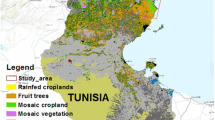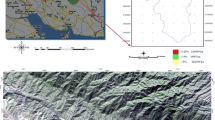Abstract
Empirical relationships between remotely sensed vegetation indices and canopy density information, such as leaf area index or ground cover (GC), are commonly used to derive spatial information in many precision farming operations. In this study, we modified an existing methodology that does not depend on empirical relationships and extended it to derive crop GC from high resolution aerial imagery. Using this procedure, GC is calculated for every pixel in the aerial imagery by dividing the perpendicular vegetation index (PVI) of each pixel by the PVI of full canopy. The study was conducted during the summer growing seasons of 2007 and 2008, and involves airborne and ground truth data from 13 agricultural fields in the Southern High Plains of the USA. The results show that the method described in this study can be used to estimate crop GC from high-resolution aerial images with an overall accuracy within 3% of their true values.







Similar content being viewed by others
References
Bagwell, R. D., Temple, J. H., Leonard, B. R., Paxton, K. W., Downer, R., Price, R., & Magoun, D. (2005). Demonstration of spatially variable plant growth regulator and defoliant treatments to cotton. In P. Dugger & D. Richter (Eds.), Proceedings of the 2005 beltwide cotton conferences (pp. 2185–2188). New Orleans, LA, 4–7 Jan 2005. Memphis, TN: National Cotton Council America.
Campbell, G. S., & Norman, J. M. (1998). An introduction to environmental physics. New York: Springer-Verlag.
Emerine, D. M. (2006). Variable and reduced rate nitrogen application based on multispectral aerial imagery and directed field sampling. In D. Richter (Ed.), Proceedings of the 2006 beltwide cotton conference (pp. 2128–2131). San Antonio, TX, 3–6 Jan 2006. Memphis, TN: National Cotton Council America.
Fitzgerald, G. J., Maas, S. J., & De Tar, W. R. (2004). Spider mite detection and canopy component mapping in cotton using hyperspectral imagery and spectral mixture analysis. Precision Agriculture, 5, 279–289. doi:10.1023/B:PRAG.0000032766.88787.5f.
Jensen, J. R. (2000). Remote sensing of the environment, an Earth resource perspective. Upper Saddle River, NJ: Prentice Hall.
Khalilian, A., Henderson, W., & Hallman, R. (2007). Site-specific application of plant growth regulators in cotton. In S. Boyd, et al. (Eds.), Proceedings of the 2007 beltwide cotton conferences (pp. 902–907). New Orleans, LA, 9–12 Jan 2007. Memphis, TN: National Cotton Council America.
Kirkpatrick, M. T., Dodds, D. M., Reynolds, D. B., Irby, J. T., Huff, J. A., O’Hara, C. G., & Willers, J. L. (2006). Utilizing aerial imagery to make site-specific defoliation applications to cotton. In D. Richter (Ed.), Proceedings of the 2006 beltwide cotton conference (p. 493). San Antonio, TX, 3–6 Jan 2006. Memphis, TN: National Cotton Council America.
Maas, S. J., Brightbill, J., & Hooton, J. (2004). Remote sensing for precision agriculture in the Texas High Plains. In P. Dugger & D. Richter (Eds.), Proceedings of the 2004 beltwide cotton conferences (pp. 184–187). San Antonio, TX, 5–9 Jan 2004. Memphis, TN: National Cotton Council America.
Maas, S. J., Brightbill, J., Lascano, R., Krieg, D., Bronson, K., Brashears, A., Hequet, E., Segarra, E., Parajulee, M., & Wanjura, D. (2003). Precision agriculture in the Texas High Plains. In J. M. LaRose (Ed.), Proceedings of the 6th annual national conservation tillage, cotton and rice conference (pp. 58–61). Perryville, MO: National Conservation Tillage Digest.
Maas, S. J., & Rajan, N. (2008). Estimating ground cover of field crops using medium-resolution multispectral satellite imagery. Agronomy Journal, 100, 320–327. doi:10.2134/agrojnl2007.0140.
Mahiny, A. S., & Turner, B. J. (2007). A comparison of four common atmospheric correction methods. Photogrammetric Engineering and Remote Sensing, 73, 361–368.
McFall, A., Teague, T. G., Coy, S., Wildy, D., Danforth, D. M., Robertson, B., Bourland, F., & Wells, D. (2004). Determining optimal timing of site-specific applications of cotton harvest aid materials using remotely sensed imagery and the COTMAN plant monitoring system. In P. Dugger & D. Richter (Eds.), Proceedings of the 2004 beltwide cotton conferences (pp. 302–307). San Antonio, TX, 5–9 Jan 2004. Memphis, TN: National Cotton Council America.
Monteith, J. L., & Unsworth, M. (1990). Principles of Environmental Physics. London, England: Arnold Publishers.
Moran, M. S., Clarke, T. R., Qi, J., Barnes, E. M., & Pinter, P. J. Jr. (1997). Practical techniques for conversion of airborne imagery to reflectances. In J. Everitt (Ed.), Proceedings of the 16th biennial workshop on videography and color photography in resource assessment (pp. 82–95). Bethesda, MD: American Society for Photogrammetry and Remote Sensing.
Ostle, B., & Mensing, R. W. (1975). Statistics in research. Ames, IA: Iowa State University Press.
Richardson, A. J., & Wiegand, C. L. (1977). Distinguishing vegetation from soil background information. Photogrammetric Engineering and Remote Sensing, 43, 1541–1552.
Richardson, A. J., Wiegand, C. L., Wanjura, D. F., Dusek, D., & Steiner, J. L. (1992). Multisite analyses of spectral-biophysical data for sorghum. Remote Sensing of Environment, 41, 71–82. doi:10.1016/0034-4257(92)90062-O.
Teague, T. G., Coy, S., Ismanov, M., Wildy, D., Danforth, D. M., & Mazaffari, M. (2005). Comparison of broadcast and image-based, variable rate application of mepiquat chloride on crop growth and fruit retention using the COTMAN crop monitoring system. In P. Dugger & D. Richter (Eds.), Proceedings of the 2005 beltwide cotton conferences (pp. 2124–2135). New Orleans, LA, 4–7 Jan 2005. Memphis, TN: National Cotton Council America.
Wiegand, C. L., Gerbermann, A. H., Gallo, K. P., Blad, B. L., & Dusek, D. (1990). Multisite analyses of spectral-biophysical data for corn. Remote Sensing of Environment, 33, 1–16. doi:10.1016/0034-4257(90)90051-M.
Wiegand, C. L., Maas, S. J., Aase, J. K., Hatfield, J. H., Pinter, P. J., Jr., Jackson, R. D., et al. (1992). Multisite analyses of spectral-biophysical data for wheat. Remote Sensing of Environment, 42, 1–21. doi:10.1016/0034-4257(92)90064-Q.
Wrona, A. F., Bradow, J. M., Bauer, P., Maas, S. J., Sadler, E. J., Clark, R., et al. (1998). Remote sensing: Value in a bird’s-eye view. Cotton Physiology Today, 9, 13–15.
Acknowledgments
The authors thank Texas Alliance for Water Conservation (TAWC) for funding the study. The authors thank Dr. Wenxuan Guo for providing technical assistance during aerial flight missions. The authors also thank Mr. Shyam. S. Nair for his help in collecting field data.
Author information
Authors and Affiliations
Corresponding author
Rights and permissions
About this article
Cite this article
Rajan, N., Maas, S.J. Mapping crop ground cover using airborne multispectral digital imagery. Precision Agric 10, 304–318 (2009). https://doi.org/10.1007/s11119-009-9116-2
Received:
Accepted:
Published:
Issue Date:
DOI: https://doi.org/10.1007/s11119-009-9116-2




